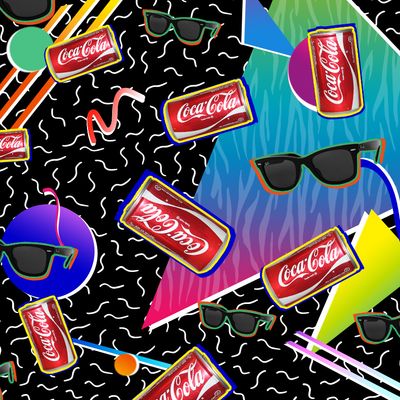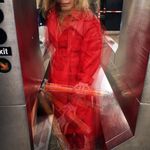
All week on Vulture, we’re examining ‘80s pop culture, and how it lives on today.
In the 1980s, Coke got into the movie business. When the soda giant acquired Columbia Pictures for $750 million in 1982, the colorful soft drink was already a mainstay in movies, with a long run of appearances starting with a billboard in The Mystery of the Leaping Fish all the way back in 1916. But by purchasing one of the country’s major studios, which had in the previous decade released movies like Close Encounters of the Third Kind and Kramer vs. Kramer, Coke helped key a major shift: Products soon made their way into the foreground of art, a place where they’ve remained ever since.
Prior to the ‘80s, Coke was far from the only brand playing the product-placement game. Trade journal Harrison’s Reports was loudly criticizing the practice all the way back in 1919, and Fritz Lang’s M features a shot in which a banner for Wrigley’s gum appears onscreen for a good 30 seconds. As one of the most recognizable American brands in the world, Coke’s placement was both notable and frequent, as much a product of the drink’s ubiquity in the real world as it was any ambitions by the corporation itself. But in the 1960s, that relationship started to become more intentional. Coke set up an office in Los Angeles to manage its involvement with the entertainment industry; meanwhile, its use as a signifier by artists like Jean-Luc Godard (who featured an intertitle in his 1966 film Masculin Féminin that read, “The children of Marx and Coca-Cola”), and Stanley Kubrick (who included a memorable scene with a Coke machine in 1964’s Dr. Strangelove), meant that the notion of Coca-Cola appearing onscreen was itself being remarked upon. More noteworthy examples followed: 1978’s Superman 2 saw Superman throw General Zod through a Coke billboard, and a Coke bottle fell from the sky in 1980’s The Gods Must Be Crazy.
But none of that quite foreshadowed Coca-Cola’s ultimate cinematic accomplishment: purchasing a studio. The sale of Columbia to Coke came on the heels of one major development in the company and just before another: Roberto Goizueta had recently become the corporation’s chairman and CEO, and Diet Coke was weeks away from its debut. Coke’s own website and archivist attributed Goizueta’s Hollywood venture to his interest in diversifying profits and shareholder value — and five years later, nobody was quite sure whether he’d been successful in that goal or not. On one hand, Columbia had released hits like The Big Chill, The Karate Kid, and Ghostbusters, as well as a Best Picture winner, Gandhi; on the other, it had Ishtar, a flop so monumental that it made Coca-Cola shareholders nervous enough to want out of movies altogether. By 1989, Columbia was in the hands of Sony, and Coca-Cola had a profit, but no studio.
Coca-Cola’s presence in moviemaking wasn’t the product-placement apocalypse — this was more a business investment than an excuse to turn water into Coke. But in many ways, it presaged the open-ended entertainment landscape of today, when any company, be it a DVDs-by-mail operation or the online marketplace where you buy paper towels, can be a purveyor of cinema. And it also, at least indirectly, led to a game-changing piece of product placement, one that would fully represent the potential opportunities of the practice for brands.
In terms of cultural resonance, Coke had been kicking Pepsi’s ass since the turn of the century, but the Columbia purchase made very clear how far ahead Coke had pulled. In direct reaction to Coke’s move, Pepsi decided to more aggressively target product placement in movies, leading to a heavy Pepsi presence in the first Back to the Future. As Adweek tells it, the executives handling Pepsi’s effort used the sequel to double down, creating a brand-new Pepsi, called Pepsi Perfect, that would exist in the future of Back to the Future Part II. Not only was Pepsi a part of a movie, then — Pepsi was a plot point, an essential aspect of the world-building. If Coke was the signpost for America, Pepsi represented the literal future.
Pepsi Perfect is generally regarded as one of the most effective pieces of product placement in the history of movies. More importantly, though, it opened the door for brands to use product placement in movies more creatively. In 1982, Hershey, makers of Reese’s Pieces, spent a million dollars on advertising for E.T. in exchange for a scene of the adorable alien eating the candy. And in 1983, Ray-Ban partnered with Risky Business to single-handedly revive Wayfarers, then repeated the trick with Top Gun and aviators; both pairs of sunglasses were so essential to Tom Cruise’s unique brand of cool that they became indivisible from the films themselves. By the end of the decade, Mac and Me and The Wizard were essentially feature-length advertisements for McDonald’s and Nintendo, respectively. Most of these were phenomenally successful, and clearly show the genes of today’s placement strategies, where characters engage with products and brands onscreen. Cruise would go on to hawk Red Stripe beer in The Firm; James Bond drove a BMW Z3 in Goldeneye, a $3 million investment that turned into $240 million worth of sales; and Heineken paid $45 million so that Bond would order one in Skyfall. (Conversely, Sideways managed to dent Merlot sales.)
The boom of the ‘80s set a precedent that Hollywood wasn’t capable of controlling. It’s not uncommon to see scripts today veer wildly off course to celebrate a brand. Recall how Cameron Diaz and Jason Segel took the time to spell out the many features of Apple’s iPad in Sex Tape, or how Modern Family shot one episode entirely through MacBook webcams. Google even wrested some measure of creative control over their extensive depiction in the fish-out-of-water comedy The Internship. Sometimes, as in Transformers, G.I. Joe, or Battleship, the product placement is the script.
The current innovation is to help the bitter elixir of product placement go down with a bit of self-flagellating humor. In last year’s Jurassic World, Bryce Dallas Howard feels sick to her stomach when she reports that Verizon Wireless will officially sponsor one of her park’s new attractions. Like similar moments in Wayne’s World and 30 Rock, the bit lets creators shill their cake and eat it too: They don’t enjoy hawking cell phones, but such are the compromises of modern life. Other writers have found a way of harvesting art from the most arid creative climate of product integration. After all, one of the most highly regarded TV series of all time concluded with its protagonist fantasizing about sharing a Coke with the entire world.
And as always, there are those who proudly and shamelessly take up the mantle of product placement. 2015’s Transformers: Age of Extinction boasted the distinction of repping 55 separate brands, while 2012’s Foodfight! turned corporate mascots into animated heroes. The ‘80s didn’t invent this trend, but they did perfect it and normalize it. Today, product placement is so indivisible from pop culture that it’s hardly worth remarking upon. Or, as one Reagan-era hero put it: Greed is good.





